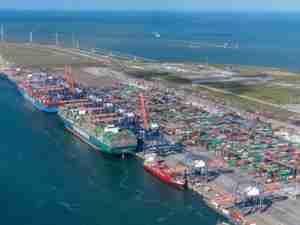The Port of Barcelona sets new record figures in foreign trade containers, vehicles and passengers
posted by AJOT | Feb 01 2017 at 10:16 AM | Ports & Terminals
The facility generated cash flow of € 86.2 M in 2016 (+17%)
The Port of Barcelona closed financial year 2016 with several new record figures in traffic, such as the volume of containerised foreign trade cargo (1,202,007 TEU - 20-foot container equivalent units), total vehicles (916,834 units) and passenger movements (3,958,960 passengers, counting ferries and cruise ships). “These three most strategic segments of activity at the Port of Barcelona registered significant year-on-year increases," declared the organisation's President Sixte Cambra during the press conference held yesterday. “The positive performance of traffic segments shows that we are well-positioned to achieve the goals we set in the Port of Barcelona Third Strategic Plan".
Regarding total containers, which are a reliable indicator of progress in the surrounding economy, the Port moved more than 2.2 million TEU (20-foot container equivalent units). This record represents an increase of 14.5%, the highest in the last decade. All sections of this traffic behaved very positively: foreign trade containers (import and export), cabotage with the Balearics and Canary Islands and transshipment (where containers are unloaded at the port to be shipped on to their final destination).
During 2016, foreign trade containers continued to increase, reflecting the efforts of the hinterland producers to open up to international markets and showing a clear recovery in domestic consumption. So it was that export container numbers grew by 3.8% (to reach 683,527 TEU) while import containers advanced at a rate of 8.7% (totalling 518,480 TEU). Meanwhile, containerised cargo in cabotage to the Spanish islands surged 10% (up to 124,455 TEU) and containers in transhipment increased by 47% (431,750 TEU). This latter figure indicates a trend towards a recovery in traffic that was severely affected during the crisis.
As far as the geographical distribution of the containers handled by the Port is concerned, Asia stands out as the origin of 77% of the imports and the recipient of 43% of exports leaving the precinct. By country, China remains the largest trading partner, since it is the origin or destination of 23% of the containers passing through the Port. The Americas account for 25% of exports and 9% of imports. United States (+7%), Mexico (+9%) and Brazil (+17%) are the fastest-growing countries in the Americas in terms of their exchanges with the Port of Barcelona.
Vehicle movements at the Port grew 4% in 2016 to reach a record 916,834 units. Most of these (778,109 cars) are foreign trade: exports continue to grow (+3%, with more than 465,000 units), while imports are progressing at a rate of 20%, although they account for fewer units in absolute terms (206,000).
Passenger movements also registered record highs, with nearly 4 million passengers (3,958,960 in total, up 6.7%), a figure that includes both ferries and cruisers. Ferry passengers (1.27 million) travelling to the Balearic Islands, Italy or North Africa increased by 9%. Meanwhile, cruise passengers numbered 2.68 million (+5.6%). Particular mention should be made of the fact that passengers in turnaround (starting and ending their cruise in Barcelona, who therefore make a greater contribution to the local economy) represented 58% of all the Port's cruise passengers, increasing by 14% in 2016. However, the number of passengers merely stopping over to visit the city for a few hours decreased by 4%.
The Port of Barcelona handled more than 370,500 ITUs of ro-ro traffic (cargo loaded onto a ship on a truck, platform or trailer), up 2.9% year on year. This business segment includes exchanges of ro ro cargo with the islands (235,400 ITUs, or intermodal transport units, up 7.4%) and traffic on the motorways of the sea or Short Sea Shipping (SSS), which channelled more than 135,000 ITUs with several destinations in Italy and North Africa. This figure means that more than 135,000 lorries were diverted from the road to the maritime mode, which is more economical and environmentally efficient because it reduces emissions.
During the period, the Port of Barcelona transported 11.4 million tons of liquid bulk, 5% less than the previous year. However, shipments of diesel/gas oil (the main hydrocarbon passing through our facility) grew by 16.4% to 2.7 million tonnes.
Meanwhile, the volume of dry bulk remained practically stable compared to the previous year, with 4.4 million tonnes handled. The top products in this section were cement and clinker, up 9%, and cereals and meal, which also increased by 9%.
Financial results
Regarding the Port of Barcelona's financial results during 2016, we should underline the organisation's considerable capacity to generate resources, with a cash flow totalling €86.2 million, a year-on-year increase of 17%.
Net turnover remained stable compared to the previous year, with € 155.3 million despite the significant cuts to Port fees applied to concessions, which are the result of new land valuation. Provisional figures for the close of the financial year indicate that the Port of Barcelona obtained profits of € 33.2 million (-16%). This decrease is due mainly to the fact that extraordinary profits were obtained in 2015 from the sale of various financial assets.
In 2016 the Port of Barcelona managed to reduce significantly the long-term debt contracted with the European Investment Bank (EIB). After the early cancellation of € 20.8 million, added to the forecast amortisation timetable, the facility reduced its debt by 13% to a current level of € 303.9 million.
During the period investments were made to the tune of € 25.9 million, the most significant of which include several works projects related to rail access, the actions on Prat wharf, extending the rail terminal on the South Dock, the new road and rail access to Alvarez de la Campa wharf and the new ice factory at the fishing facilities, among others.










